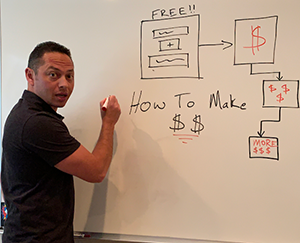Weekend Favs July 6 written by John Jantsch read more at Duct Tape Marketing
My weekend blog post routine includes posting links to a handful of tools or great content I ran across during the week. I don’t go into depth about the finds, but I encourage you to check them out if they sound interesting. The photo in the post is a favorite for the week from an […]
Why Today’s Training Methods are Failing written by John Jantsch read more at Duct Tape Marketing
The Duct Tape Marketing Podcast with John Jantsch
In this episode of the Duct Tape Marketing Podcast, I interviewed Matt Beane, an assistant professor in the Technology Management Department at the University of California, Santa Barbara, and a digital fellow with Stanford’s Digital Economy Lab and MIT’s Institute for Digital Economy.
He conducts field research on the future of work involving robots and AI, exploring how these technologies are reshaping skill development and training in various industries. His latest book, “The Skill Code: How to Save Human Ability in an Age of Intelligent Machines,” breakdowns the significant shifts in how skills are acquired in the modern workforce.
Key Takeaways
Questions I ask Matt Beane:
[02:02] What led you to into the field of studying master-taught lost skills in the workplace?
[08:08] Asides from the Medical industry, What other industries did you study that your learnings apply to?
[11:13] Did you have any industries that questioned your goals?
[13:54] Are there other factors besides technology such as organizational culture that contribute to lost skills?
[15:09] Is there a way that organizations can protect their “learned skill and knowledge base”, or those obsolete?
More About Matt Beane:
Connect with Matt Beane on LinkedIn
Visit his Website
Read the first chapter of The Skill Code
Like this show? Click on over and give us a review on iTunes, please!
Connect with John Jantsch on LinkedIn
This episode of The Duct Tape Marketing Podcast is brought to you by ActiveCampaign
Try ActiveCampaign free for 14 days with our special offer. Exclusive to new customers—upgrade and grow your business with ActiveCampaign today!
Speaker 1 (00:00): I was like, I found it. I found it. This is what I’ve been looking for. I can honestly say it has genuinely changed the way I run my business. It’s changed the results that I’m seeing. It’s changed my engagement with clients. It’s changed my engagement with the team. I couldn’t be happier. Honestly. It’s the best investment I ever
John Jantsch (00:16): Made. What you just heard was a testimonial from a recent graduate of the Duct Tape Marketing certification intensive program for fractional CMOs marketing agencies and consultants just like them. You could choose our system to move from vendor to trusted advisor, attract only ideal clients, and confidently present your strategies to build monthly recurring revenue. Visit DTM world slash scale to book your free advisory call and learn more. It’s time to transform your approach. Book your call today, DTM World slash scale.
(01:03): Hello and welcome to another episode of the Duct Tape Marketing Podcast. This is John Jantsch. My guest today is Matt Beane. He does field research on work involving robots and AI to uncover systematic positive exceptions that we use across the broader world of work. He’s an assistant professor in the technology management department at the University of California Santa Barbara and a digital fellow with Stanford’s Digital Economy Lab and MIT’s Institute for Digital Economy. He received his PhD from the MIT Sloan School of Management. We’re going to talk about his book today, the Skill Code, how to Save Human Ability in an Age of Intelligent Machines. So Matt, welcome to the show.
Matt Beane (01:49): Delighted to be here. Really appreciated the invite and excited to talk.
John Jantsch (01:53): We’re going to do our best to save human ability today. I think that sounds like a noble goal. So the premise, I’ll be very brief and let you talk more about it, but the premise of the book is this idea that we’re losing a lot of skills that the master taught the apprentice over centuries of time. So kind of led you to studying that particular gap or space,
Matt Beane (02:17): Right? The gap I wasn’t sure was going to be there. I’ve always been interested in training, learning and skill development my whole career one way or another. And since about 2000 and the confluence of that in AI and robotics got my fierce and firm attention. When it came time to pick a dissertation focus at MIT, I knew robotic surgery was a very interesting place to go because it boy, oh boy, doing robotic surgery is radically different than doing it the old fashioned way or even the modern way before that, which was with straight sticks, basically laparoscopic surgery as we knew about it in the nineties. And I just looked at the control apparatus for that robot, and it’s a giant Xbox controller basically with a 3D vision goggles that you wear and foot control. So you’re using your feet and your hands and I’m like, this bears almost no resemblance to the old fashioned way. How did you learn
John Jantsch (03:13): How to do? Yeah, the parts are looking at are called the same thing. But other than that, right?
Matt Beane (03:16): Yeah, no kidding. Although by the way, looking at it through this robot, you’re seeing it at 10 x magnification and an inch movement on the outside with your hands and the controller translates to a millimeter on the inside. So it’s a real different game. I didn’t know all that to begin with, but I figured the training for this has got to be real different for the training the old school way. How does it work? What are the upsides? What are the downsides? That’s the sort of going in question after no more than three months in the field in the operating room, watching real procedures with this thing, talking to residents, talking to surgeons, it was very obvious that everyone was assuming the way to learn how to use this thing is the same way that you should learn how to do the old procedure. And that was a fatal assumption, turned out to be false because, and by the way, the old school way is something we have encoded almost in our DNA.
(04:09): It’s literally 160,000 years old in surgery. They call this C one, do one, teach one. You basically show up, help a little bit, watch, get a little bit more involved as the expert decides you’re ready and sooner or later you’ve got somebody looking over your shoulder. Look at any profession I defy you. The book is full of examples of this. We just take that for granted as the way that you learn how to do stuff and build skill, which is the ability to do the thing under pressure basically reliably. That’s different than knowing conceptually. Like book smart. This is like, can you do it? So anyway, it turns out that mechanism of learning, this taken for granted thing, it was getting busted in robotic surgery because the console and the controller allowed the senior surgeon to do the whole thing themselves. So the resident becomes an optional participant at that point.
(05:00): I have to make mental effort to involve that person who wants to become me someday and there’s a patient on the table and therefore I’m never going to do that because they’re going to be slower and make more mistakes than me. So instead of the old school way, a four and a half hour procedure, that resident is busy for actually about six hours. They are working from before the patient gets, there’s any incision all the way till well afterwards they’re sweating the whole time and they’re helping out in consequential work. Now, they might be swimming in the shallow end of the pool, but they’re swimming now. They show up, help get that robot doc to the patient, sit in a separate control console and they watch a movie. That’s all they get to do. And so that was no one. Everyone recognized that was unsatisfactory on some level, but boy oh boy, they were just kind of tolerating it and surgeons would come out of programs after six years of big air quotes training. I have, well, I quote a chief of urology for one of the top hospitals in the states and he said, top surgeons suck. Now. That’s what he said to me, to my face. They’ve watched a lot of surgery, they haven’t done it. We have to retrain them when they arrive. So it was about halfway through that study that I realized most of what I just told you, because
Jo
Related Posts
Recommended Story For You :

The Step-By-Step “Profit Engine” Blueprint.

How To Make $3493 Commissions Without Doing Any Selling

Successful dropshippers have reliable suppliers.

People Think I Use A Professional Voiceover Artist. NO! I Just Use Speechelo!

Make Money Testing Apps On Your Phone Or Tablet

Make More Money or Lose Everything

Sqribble Is The ONLY eBook Creator You’ll Ever Need.

Work & Earn as an Online Assistant

Create Ongoing Income Streams Of $500 To $1000 Or More Per Day

